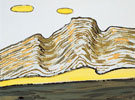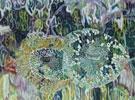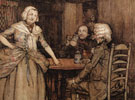Between Reality and Reverie
—— Li Hongjun’s Paper Art
By Yin Shuangxi
With the development of Chinese Contemporary Art, Li Hongjun can not be regarded as a young artist nor a latecomer of Fine Arts, who has more than 30 years’ art experiences, meanwhile, coming and going from Shaanxi province to Beijing for several times. Started from the folk paper-cutting, he has been painted fine brushwork paintings in peasantry style, made black and white wood block in Gu Yuan style, painted oil paintings similar to Kitsch Art and also done a fantastic surreal sketch “Landscape in Three Sides” in his art experiences. However, he caught people’s eye in recent years. Li Hongjun, an artist from Shaanxi province, has got his master’s degree with the major of Experimentation Art in Central Academy of Fine Arts in 2009 after he finished his study in the department of Folk Art and Experimentation Art in Central Academy of Fine Arts, eventually, accomplished his transition from folk art to contemporary art. Li Hongjun has been found the internal consistency of these two kinds of art which seems totally different in art style after experienced too much, that is, love for life, persistent pursuit for imagination and creation, and using unique symbol to express artist’s sensation and understanding of nature and society. Spider and head portrait were regarded as representations in his earlier works which showed a deep realization of life undergoing and destiny, while “Possessed by the Devil” series was the most important series which he combined folk art with West Modern Paintings together, meanwhile, possessed the nightmare traits of GOYA Art and the romantic imaginations of Chinese Traditional “Classic of Mountains and Seas” style.
In the exhibition of “the First Art Exhibition of Master’s Admission” held by Central Academy of Fine Arts in 2005, Li Hongjun’s installation “Red, White, and Black” was regarded as his first step from painting to contemporary art. First, he sprayed the oil onto flowers, and then put them into vase with the same color, displayed it on the table at last. Here, the live biology from nature was wrapped into a chemical substance after human’s behavior and then presented a mendacious hand-make conformation. Li Hongjun realized life and death, reality and illusion at the first time, that is, there was a huge difference between the intrinsic when the appearance morphology of the object is unchanged, while the difference was coexisted in the same object and in a constantly changing process. As a matter of fact, Li Hongjun has already paid attention to the isomorphic relations of heterogeneity between natural objects such as ice and water, stone and sand, dead fish and live fish in his installation “Red Spider Ι Series No.2-5”, especially the conversion space of the existing objects such as the vacuity of life and dead, space-time distance of reality and illusion. According to this point, Li Hongjun’s works express the same idea with the German Anatomy doctor Guenter Von Hagens’s works who only displays plasticized human specimens.
In recent years, Li Hongjun’s paper installations appeared suddenly and became more and more active. It is a reasonable result which he kicks different artistic media more than 30 years and also his mastery harvest among different artistic Medias. Li Hongjun’s paper works are made of paper layer by layer, and then dig the image out, after digging the negative configuration also becomes a part of the whole work. We can say this principle is not created by Li Hongjun, is a precious heritage left by Chinese Traditional Paper-cut. I remembered that Lv Shengzhong had converted folk paper-cut into the armor-plate engraving and displayed a negative and positive shape Chihuahua in the grass in the process of the old creative practice. However, Li Hongjun’s unique exists in his visual experience of space and volume after received art trainings of academy. He converted complanate positive and negative shape into three-dimensional positive and negative shape and made it have a independent sculpture conformation, furthermore, displayed his installation works through different materials and body combinations in art space. Actually, from his “Dao·Utensils” series in 1995, he used big thick books to dig up all sorts of living appliance and then displayed books and the living appliance together. Because the scale and conformation was too small at that time, so the human image was not appeared. Although we have already known this pattern and we also have seen people used this way to take secret files and smuggle objects in the old cinema, the form of this language pattern has a decisive significance for Li Hongjun.
Once Li Hongjun converted this way into human images, the innovation of this language pattern would become a break point. When the head portrait digged up from the books sited there and watched the vacant big dictionary, even if the two hands which turn over the books, we would come into a displaced reverie space between reality and transience. Is the ideology language created by human beings agglomerating a kind of productive pattern of spiritual civilization, or the language of books forming and controlling human brain? When we see Li Hongjun’s surreal head portraits, we need to think about the civil evolution of human itself eventually result in between human beings and the creature, which is more real, and which has more possibility of historical heritage issues. The white characters created by Li hongjun with social characteristics and without costume marked self at first and adopted self-image in visualization, which seems to solve the individual confusion such as “who am I? Where am I from? Where should I go? But in my view, the audience who doesn’t know well about Li Hongjun’s characteristics can not see a concrete person. His works more like a kind of capitalized symbol of human beings, its creation and existence which seems like a sculpture has originality of ancient and immutability of future.




